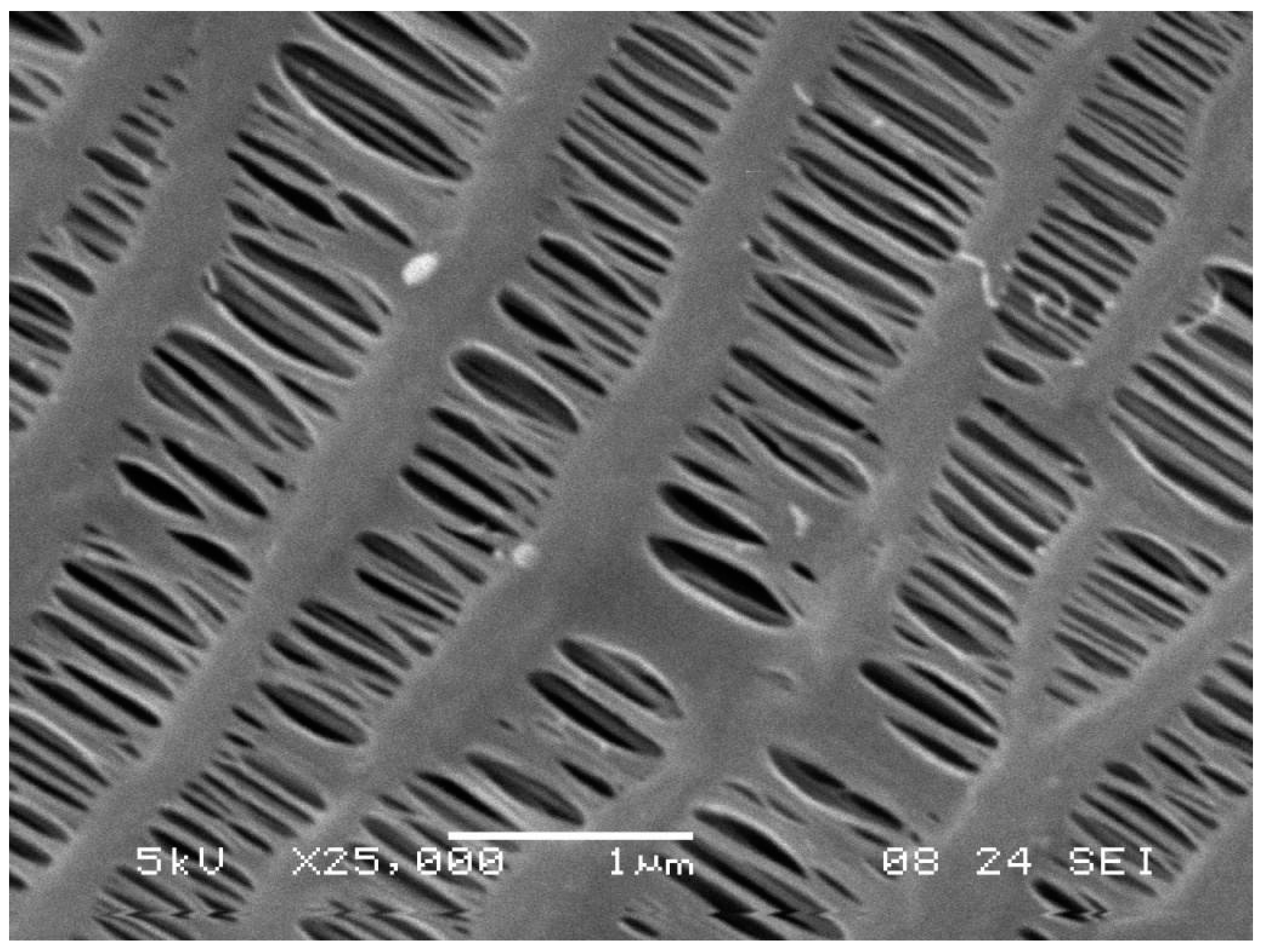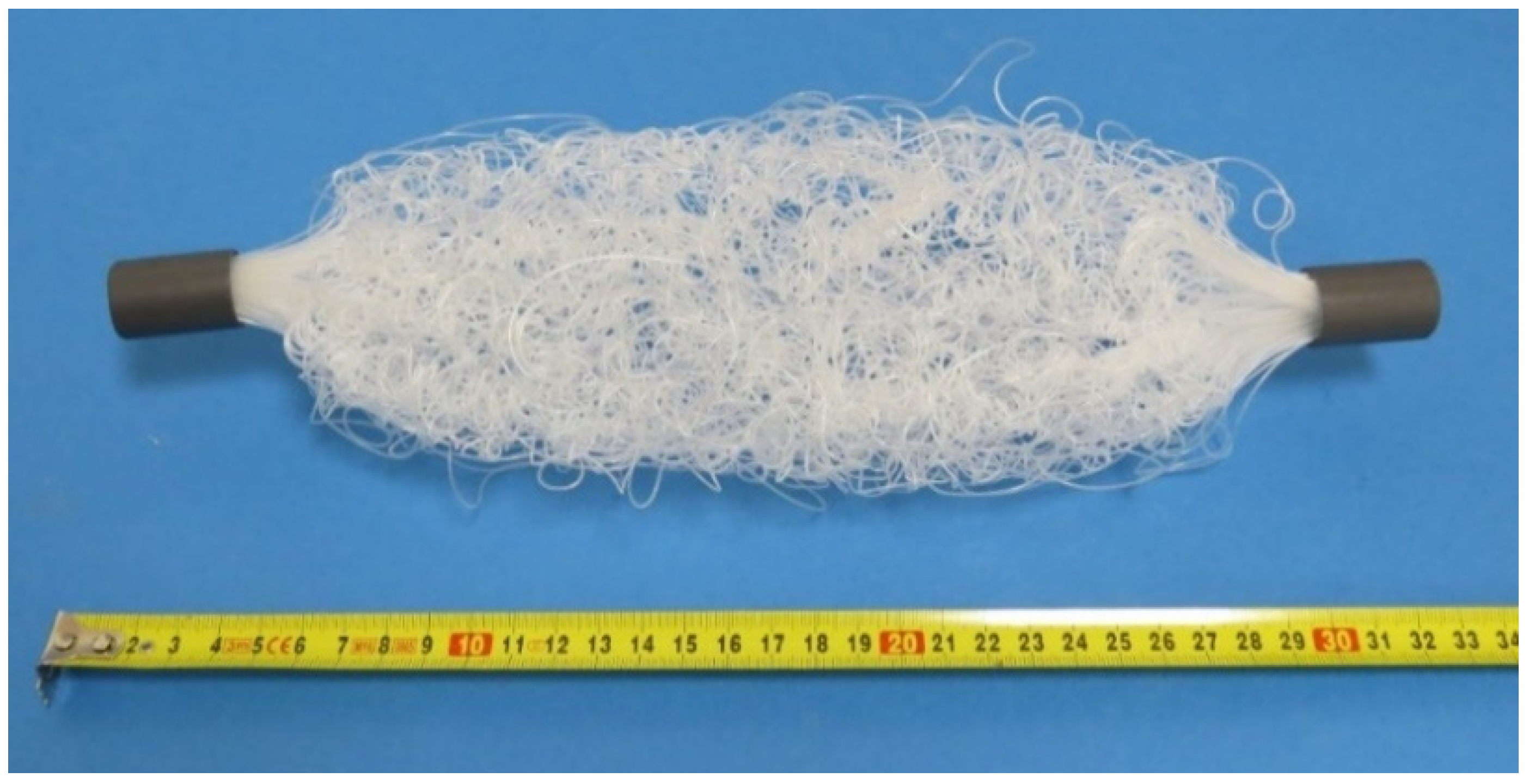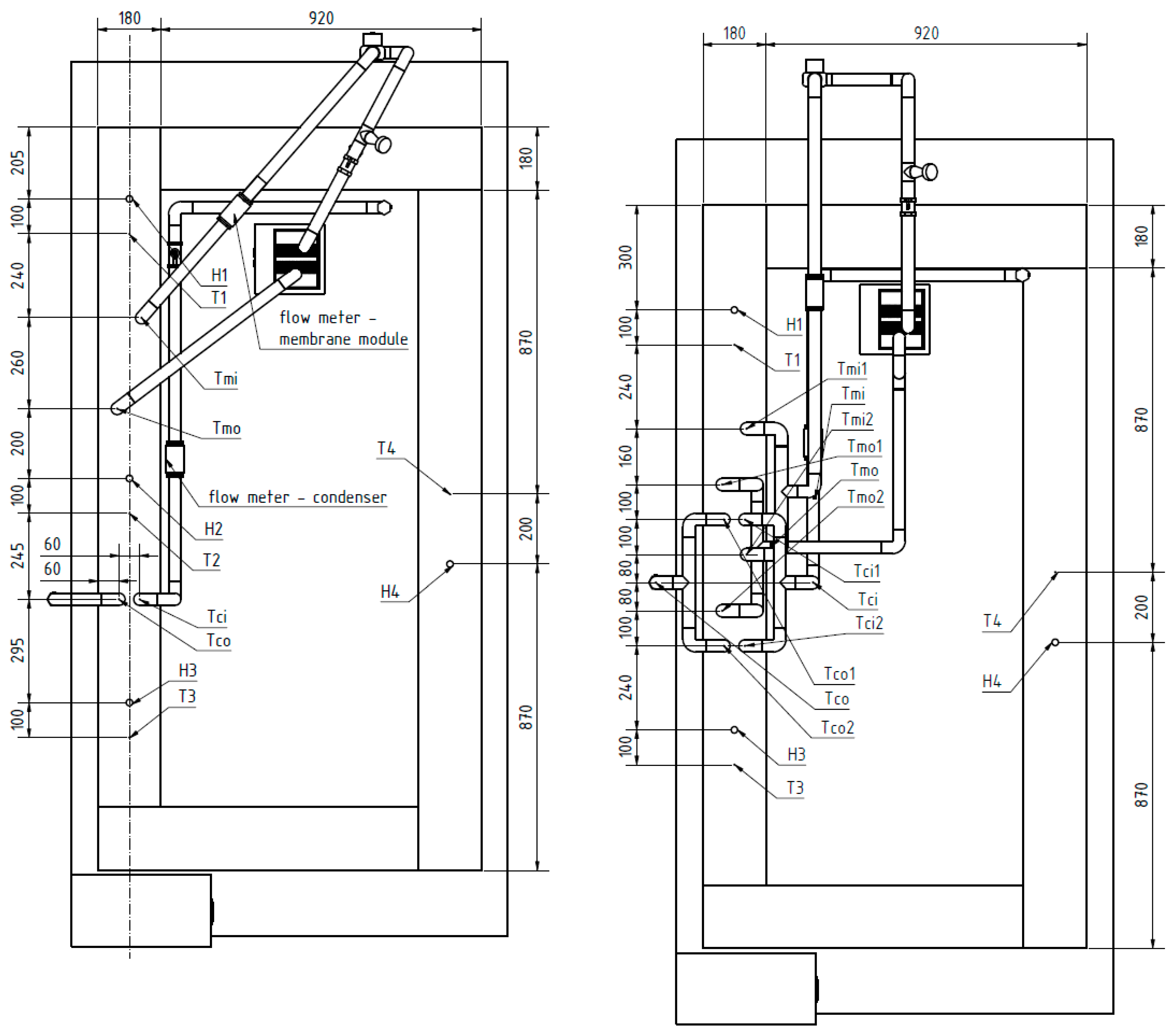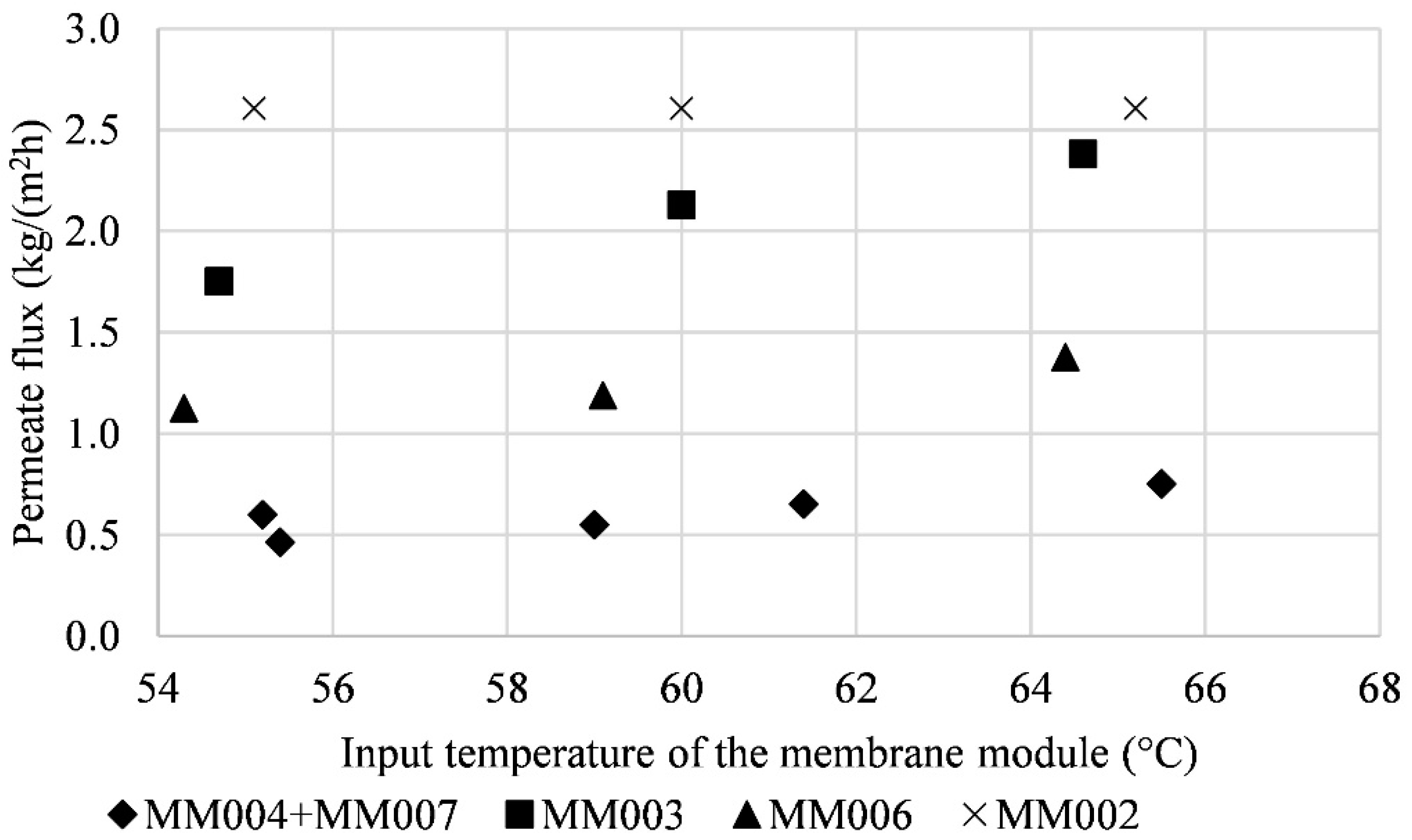Fully Polymeric Distillation Unit Based on Polypropylene Hollow Fibers
Abstract
:1. Introduction
2. Materials and Methods
2.1. Methods
2.2. Experimental Part
3. Results
3.1. Four-Bundle Membrane Module
3.2. Membrane Modules with Bundles Consisting of 500 Fibers
3.3. Membrane Modules with Bundles Consisting of 300 Fibers
3.4. Membrane Module with Bundle Consisting of 200 Fibers
4. Discussion
5. Conclusions
6. Patents
Author Contributions
Funding
Institutional Review Board Statement
Informed Consent Statement
Data Availability Statement
Conflicts of Interest
References
- Camacho, L.M.; Dumée, L.; Zhang, J.; Li, J.; Duke, M.; Gomez, J.; Gray, S. Advances in Membrane Distillation for Water Desalination and Purification Applications. Water 2013, 5, 94–196. [Google Scholar] [CrossRef] [Green Version]
- Khayet, M. Membranes and theoretical modeling of membrane distillation: A review. Adv. Colloid Interface Sci. 2011, 164, 56–88. [Google Scholar] [CrossRef] [PubMed]
- Bernauer, B.; Bleha, M.; Bouzek, K.; Černín, A.; Fíla, V.; Friess, K.; Izák, P.; Jiránková, H.; Kárászová, M.; Kočiřík, M.; et al. Membránové Procesy, 1st ed.; Palatý, Z., Ed.; VŠCHT: Praha, Czech Republic, 2012. [Google Scholar]
- Sørensen, E.; Lam, K.F.; Sudhoff, D. Chapter 9—Special Distillation Applications. In Distillation; Górak, A., Schoenmakers, H., Eds.; Academic Studies Press: Boston, MA, USA, 2014; pp. 367–401. [Google Scholar]
- Koschikowski, J.; Wieghaus, M.; Rommel, M. Solar Thermal-Driven Desalination Plants Based on Membrane Distillation. Desalination 2003, 156, 295–304. [Google Scholar] [CrossRef]
- Bulejko, P. Numerical Comparison of Prediction Models for Aerosol Filtration Efficiency Applied on a Hollow-Fiber Membrane Pore Structure. Nanomaterials 2018, 8, 447. [Google Scholar] [CrossRef] [Green Version]
- Sverak, T.; Bulejko, P.; Ostrezi, J.; Kristof, O.; Kalivoda, J.; Kejik, P.; Mayerova, K.; Adamcik, M. Separation of Gaseous Air Pollutants Using Membrane Contactors. IOP Conf. Ser. Earth Environ. Sci. 2017, 92, 012061. [Google Scholar] [CrossRef] [Green Version]
- Bulejko, P.; Svěrák, T.; Dohnal, M.; Pospíšil, J. Aerosol Filtration Using Hollow-Fiber Membranes: Effect of Permeate Velocity and Dust Amount on Separation of Submicron TiO2 Particles. Powder Technol. 2018, 340, 344–353. [Google Scholar] [CrossRef]
- Bulejko, P.; Krištof, O.; Dohnal, M.; Svěrák, T. Fine/Ultrafine Particle Air Filtration and Aerosol Loading of Hollow-Fiber Membranes: A Comparison of Mathematical Models for the Most Penetrating Particle Size and Dimensionless Permeability with Experimental Data. J. Membr. Sci. 2019, 592, 117393. [Google Scholar] [CrossRef]
- Lam, K.F.; Sorensen, E.; Gavriilidis, A. Review on Gas—Liquid Separations in Microchannel Devices. Chem. Eng. Res. Des. 2013, 91, 1941–1953. [Google Scholar] [CrossRef]
- Schofield, R.W.; Fane, A.G.; Fell, C.J.D. Heat and Mass Transfer in Membrane Distillation. J. Membr. Sci. 1987, 33, 299–313. [Google Scholar] [CrossRef]
- Koplik, J.; Banavar, J.R.; Willemsen, J.F. Molecular Dynamics of Poiseuille Flow and Moving Contact Lines. Phys. Rev. Lett. 1988, 60, 1282–1285. [Google Scholar] [CrossRef]
- Alkhudhiri, A.; Darwish, N.; Hilal, N. Membrane Distillation: A Comprehensive Review. Desalination 2012, 287, 2–18. [Google Scholar] [CrossRef]
- Curcio, E.; Drioli, E. Membrane distillation and related operations—A review. Sep. Purif. Rev. 2005, 34, 35–86. [Google Scholar] [CrossRef]
- Eckardt, N.A.; Cominelli, E.; Galbiati, M.; Tonelli, C. The future of science: Food and water for life. Plant Cell 2009, 21, 368–372. [Google Scholar] [CrossRef]
- Shirazi, M.M.A.; Kargari, A.; Shirazi, M.J.A. Direct contact membrane distillation for seawater desalination. Desalination Water Treat. 2012, 49, 368–375. [Google Scholar] [CrossRef]
- Shiklomanov, I.A. World fresh water resources. In Water in Crisis: A Guide to the World’s Fresh Water Resources; Gleick, P.H., Ed.; Oxford University Press: New York, NY, USA, 1993. [Google Scholar]
- Gryta, M. Concentration of Saline Wastewater from the Production of Heparin. Desalination 2000, 129, 35–44. [Google Scholar] [CrossRef]
- Eykens, L.; De Sitter, K.; Dotremont, C.; Pinoy, L.; van der Bruggen, B. Membrane Synthesis for Membrane Distillation: A Review. Sep. Purif. Technol. 2017, 182, 36–51. [Google Scholar] [CrossRef]
- Franken, A.C.M.; Nolten, J.A.M.; Mulder, M.H.V.; Bargeman, D.; Smolders, C.A. Wetting Criteria for the Applicability of Membrane Distillation. J. Membr. Sci. 1987, 33, 315–328. [Google Scholar] [CrossRef] [Green Version]
- Kwok, D.Y.; Neumann, A.W. Contact Angle Measurement and Contact Angle Interpretation. Adv. Colloid Interface Sci. 1999, 81, 167–249. [Google Scholar] [CrossRef]
- Brozova, T.; Raudensky, M. Determination of Surface Wettability of Polymeric Hollow Fibres. J. Elastomers Plast. 2018, 50, 737–746. [Google Scholar] [CrossRef]
- Lawson, K.W.; Lloyd, D.R. Membrane Distillation. J. Membr. Sci. 1997, 124, 1–25. [Google Scholar] [CrossRef]
- Khayet, M.; Khulbe, K.C.; Matsuura, T. Characterization of Membranes for Membrane Distillation by Atomic Force Microscopy and Estimation of Their Water Vapor Transfer Coefficients in Vacuum Membrane Distillation Process. J. Membr. Sci. 2004, 238, 199–211. [Google Scholar] [CrossRef]
- Al-Obaidani, S.; Curcio, E.; Macedonio, F.; Di Profio, G.; Al-Hinai, H.; Drioli, E. Potential of Membrane Distillation in Seawater Desalination: Thermal Efficiency, Sensitivity Study and Cost Estimation. J. Membr. Sci. 2008, 323, 85–98. [Google Scholar] [CrossRef]
- Bonyadi, S.; Chung, T.S. Flux Enhancement in Membrane Distillation by Fabrication of Dual Layer Hydrophilic—Hydrophobic Hollow Fiber Membranes. J. Membr. Sci. 2007, 306, 134–146. [Google Scholar] [CrossRef]
- ZENA MEMBRANES. Available online: http://www.zena-membranes.cz/ (accessed on 8 July 2020).
- Du, H.; Li, J.; Zhang, J.; Su, G.; Li, X.; Zhao, Y. Separation of Hydrogen and Nitrogen Gases with Porous Graphene Membrane. J. Phys. Chem. C 2011, 115, 23261–23266. [Google Scholar] [CrossRef]
- Kullab, A.; Martin, A. Membrane Distillation and Applications for Water Purification in Thermal Cogeneration Plants. Sep. Purif. Technol. 2011, 76, 231–237. [Google Scholar] [CrossRef]
- Hausmann, A.; Sanciolo, P.; Vasiljevic, T.; Weeks, M.; Schroën, K.; Gray, S.; Duke, M. Fouling Mechanisms of Dairy Streams during Membrane Distillation. J. Membr. Sci. 2013, 441, 102–111. [Google Scholar] [CrossRef] [Green Version]
- Ding, Z.; Liu, L.; Yu, J.; Ma, R.; Yang, Z. Concentrating the Extract of Traditional Chinese Medicine by Direct Contact Membrane Distillation. J. Membr. Sci. 2008, 310, 539–549. [Google Scholar] [CrossRef]
- Gryta, M. Fouling in Direct Contact Membrane Distillation Process. J. Membr. Sci. 2008, 325, 383–394. [Google Scholar] [CrossRef]
- Ge, J.; Peng, Y.; Li, Z.; Chen, P.; Wang, S. Membrane Fouling and Wetting in a DCMD Process for RO Brine Concentration. Desalination 2014, 344, 97–107. [Google Scholar] [CrossRef]
- Chen, G.; Yang, X.; Wang, R.; Fane, A.G. Performance Enhancement and Scaling Control with Gas Bubbling in Direct Contact Membrane Distillation. Desalination 2013, 308, 47–55. [Google Scholar] [CrossRef] [Green Version]
- Gryta, M. Polyphosphates Used for Membrane Scaling Inhibition during Water Desalination by Membrane Distillation. Desalination 2012, 285, 170–176. [Google Scholar] [CrossRef]
- Al-Janabi, A.; Malayeri, M.R.; Guillén-Burrieza, E.; Blanco, J. Field Evaluation of Coated Plates of a Compact Heat Exchanger to Mitigate Crystallization Deposit Formation in an MD Desalination Plant. Desalination 2013, 324, 21–33. [Google Scholar] [CrossRef]
- Zarkadas, D.M.; Sirkar, K.K. Polymeric Hollow Fiber Heat Exchangers: An Alternative for Lower Temperature Applications. Ind. Eng. Chem. Res. 2004, 43, 8093–8106. [Google Scholar] [CrossRef]
- Brozova, T. Phase Changes on Heat Exchanger Surfaces with Hollow Fibers. Ph.D. Thesis, Brno University of Technology, Brno, Czech Republic, 2018. [Google Scholar]
- Astrouski, I.; Raudensky, M. The Study of Polymeric Hollow Fiber Heat Exchangers. In Proceedings of the Engineering Mechanics 2012, Svratka, Czech Republic, 14–17 May 2012; pp. 47–57. [Google Scholar]
- Heat Transfer and Fluid Flow Laboratory—Brno University of Technology, Faculty of Mechanical Engineering. Available online: https://www.heatlab.cz/ (accessed on 12 January 2021).
- Raudenský, M.; Astrouski, I.; Dohnal, M. Intensification of Heat Transfer of Polymeric Hollow Fiber Heat Exchangers by Chaotisation. Appl. Therm. Eng. 2017, 113, 632–638. [Google Scholar] [CrossRef]
- Bartuli, E.; Raudensky, M. The Influence of Hollow Fibers Orientation inside the Polymeric Hollow Fiber Heat Exchanger on the Heat Transfer Intensity. In Proceedings of the Engineering Mechanics 2018, Svratka, Czech Republic, 14–17 May 2018; pp. 61–64. [Google Scholar]
- Bartuli, E.; Kůdelová, T.; Raudenský, M. Shell-and-Tube Polymeric Hollow Fiber Heat Exchangers with Parallel and Crossed Fibers. Appl. Therm. Eng. 2021, 182, 116001. [Google Scholar] [CrossRef]
- Astrouski, I.; Raudensky, M.; Dohnal, M. Fouling of Polymeric Hollow Fiber Heat Exchanger by Wastewater. Chem. Eng. Trans. 2015, 45, 949–954. [Google Scholar] [CrossRef]
- Astrouski, I. Polymeric Hollow Fiber Heat Exchanger Design. Ph.D. Thesis, Brno University of Technology, Brno, Czech Republic, 2016. [Google Scholar]
- Brožová, T.; Luks, T.; Astrouski, I.; Raudenský, M. Fatigue Testing of Polymeric Hollow Fibre Heat Transfer Surfaces by Pulsating Pressure Loads. Available online: https://www.scientific.net/AMM.821.3 (accessed on 8 July 2020).
- Weiß, K.; Astrouski, I.; Reppich, M.; Raudenský, M. Polymeric Hollow-Fiber Bundles as Immersed Heat Exchangers. Chem. Eng. Technol. 2018, 41, 1457–1465. [Google Scholar] [CrossRef]
- Krásný, I.; Astrouski, I.; Raudenský, M. Polymeric Hollow Fiber Heat Exchanger as an Automotive Radiator. Appl. Therm. Eng. 2016, 108, 798–803. [Google Scholar] [CrossRef]
- Brozova, T.; Bartuli, E. Influence of Condensation on the Outer Surface of Polymer Hollow Fiber Heat Exchangers During Heat Transfer; ASME Digital Collection: New York, NY, USA, 2018. [Google Scholar]
- Brozova, T.; Bartuli, E.; Raudensky, M. Condensation on the Outer Surface of Polymer Hollow Fiber Heat Exchangers and Its Influence to the Heat Transfer. In Proceedings of the Engineering Mechanics 2018, Svratka, Czech Republic, 14–17 May 2018; pp. 117–120. [Google Scholar]
- Raudenský, M.; Astrouski, I.; Brožová, T.; Bartuli, E. Flexible Polymeric Hollow Fiber Heat Exchangers for Electronic Systems. In Proceedings of the 2016 15th IEEE Intersociety Conference on Thermal and Thermomechanical Phenomena in Electronic Systems (ITherm), Las Vegas, NV, USA, 31 May–3 June 2016; pp. 1143–1147. [Google Scholar]
- Bohacek, J.; Raudensky, M.; Kroulikova, T.; Karimi-Sibaki, E. Polymeric Hollow Fibers: A Supercompact Cooling of Li-Ion Cells. Int. J. Therm. Sci. 2019, 146, 106060. [Google Scholar] [CrossRef]
- El-Bourawi, M.S.; Ding, Z.; Ma, R.; Khayet, M. A Framework for Better Understanding Membrane Distillation Separation Process. J. Membr. Sci. 2006, 285, 4–29. [Google Scholar] [CrossRef]
- Drioli, E.; Criscuoli, A.; Curcio, E. Membrane Contactors: Fundamentals, Applications and Potentialities; Elsevier: Amsterdam, The Netherlands, 2005. [Google Scholar]
- Summers, E.K.; Arafat, H.A.; Lienhard, J.H. Energy Efficiency Comparison of Single-Stage Membrane Distillation (MD) Desalination Cycles in Different Configurations. Desalination 2012, 290, 54–66. [Google Scholar] [CrossRef]
- Cerneaux, S.; Strużyńska, I.; Kujawski, W.M.; Persin, M.; Larbot, A. Comparison of Various Membrane Distillation Methods for Desalination Using Hydrophobic Ceramic Membranes. J. Membr. Sci. 2009, 337, 55–60. [Google Scholar] [CrossRef]
- Ding, Z.; Liu, L.; Li, Z.; Ma, R.; Yang, Z. Experimental Study of Ammonia Removal from Water by Membrane Distillation (MD): The Comparison of Three Configurations. J. Membr. Sci. 2006, 286, 93–103. [Google Scholar] [CrossRef]
- Souhaimi, M.K.; Matsuura, T. Membrane Distillation: Principles and Applications, 1st ed.; Elsevier: Amsterdam, The Netherlands, 2011. [Google Scholar]
- Dosal. Available online: http://ebc.steno.cz/produkt/dosal (accessed on 8 July 2020).
- Matheswaran, M.; Kwon, T.O.; Kim, J.W.; Moon, I.S. Factors Affecting Flux and Water Separation Performance in Air Gap Membrane Distillation. J. Ind. Eng. Chem. 2007, 13, 965–970. [Google Scholar]
- Geng, H.; Wu, H.; Li, P.; He, Q. Study on a New Air-Gap Membrane Distillation Module for Desalination. Desalination 2014, 334, 29–38. [Google Scholar] [CrossRef]
- Ho, C.-D.; Chen, L.; Huang, M.-C.; Lai, J.-Y.; Chen, Y.-A. Distillate Flux Enhancement in the Air Gap Membrane Distillation with Inserting Carbon-Fiber Spacers. Sep. Sci. Technol. 2017, 52, 2817–2828. [Google Scholar] [CrossRef]
- Eykens, L.; Reyns, T.; De Sitter, K.; Dotremont, C.; Pinoy, L.; van der Bruggen, B. How to Select a Membrane Distillation Configuration? Process Conditions and Membrane Influence Unraveled. Desalination 2016, 399, 105–115. [Google Scholar] [CrossRef]









| Membrane Module | No. of Fibers | OD (mm) | ID (mm) | Fiber Length (mm) | Mass Transfer Area (m2) | Note |
|---|---|---|---|---|---|---|
| MM001 | 4000 | 0.33 | 0.24 | 300 | 1.24 | four-bundle membrane module |
| MM002 | 200 | 0.6 | 0.48 | 140 | 0.06 | single-bundle membrane module |
| MM003 | 300 | 0.6 | 0.48 | 140 | 0.08 | single-bundle membrane module |
| MM004 | 500 | 0.6 | 0.48 | 140 | 0.14 | single-bundle membrane module |
| MM006 | 600 | 0.6 | 0.48 | 140 | 0.16 | double-bundle membrane module |
| MM007 | 1000 | 0.6 | 0.48 | 140 | 0.29 | double-bundle membrane module |
| Qm (L/h) | Tmi (°C) | Tmo (°C) | Tci (°C) | Tco (°C) | H1 (%) | T1 (°C) | H2 (%) | T2 (°C) | H3 (%) | T3 (°C) | H4 (%) | T4 (°C) | |
|---|---|---|---|---|---|---|---|---|---|---|---|---|---|
| EX01 | 60 | 55.1 | 52.2 | 10.6 | 11.1 | 83.3 | 19.9 | 93.2 | 24.9 | 88.0 | 17.3 | 88.2 | 19.0 |
| EX02 | 100 | 55.1 | 53.4 | 10.6 | 11.1 | 82.7 | 19.8 | 93.4 | 24.6 | 89.7 | 17.4 | 85.9 | 19.0 |
| EX03 | 60 | 60.1 | 57.2 | 10.5 | 11.0 | 93.2 | 19.5 | 92.7 | 25.1 | 89.6 | 17.7 | 85.0 | 18.7 |
| EX04 | 100 | 60.2 | 58.5 | 10.2 | 10.7 | 81.0 | 19.6 | 93.3 | 24.8 | 85.8 | 17.3 | 84.1 | 18.8 |
| EX05 | 60 | 65.0 | 61.9 | 10.7 | 11.2 | 82.6 | 20.1 | 93.3 | 26.2 | 86.6 | 18.2 | 89.0 | 19.3 |
| EX06 | 100 | 65.1 | 63.0 | 10.6 | 11.2 | 83.8 | 20.1 | 93.7 | 26.1 | 86.4 | 18.2 | 86.7 | 19.3 |
| Qm (L/h) | Thermal Performance (kW) | Error (%) | Amount of Condensate (mL/h) | Permeate Flux (kg/m2h) | Pressure Drop of Membrane Module (kPa) | |
|---|---|---|---|---|---|---|
| EX01 | 60 | 0.73 | 3 | 780 | 0.62 | 26 |
| EX02 | 100 | 0.72 | 5 | 790 | 0.64 | 44 |
| EX03 | 60 | 0.73 | 3 | 800 | 0.66 | 23 |
| EX04 | 100 | 0.72 | 5 | 880 | 0.71 | 40 |
| EX05 | 60 | 0.78 | 3 | 950 | 0.77 | 21 |
| EX06 | 100 | 0.88 | 3 | 976 | 0.79 | 35 |
| Qm (L/h) | Tmi (°C) | Tmo (°C) | Tci (°C) | Tco (°C) | H1 (%) | T1 (°C) | H3 (%) | T3 (°C) | H4 (%) | T4 (°C) | |
|---|---|---|---|---|---|---|---|---|---|---|---|
| EX07 | 100 | 55.4 | 53.3 | 11.5 | 11.8 | 68.6 | 21.6 | 86.2 | 17.1 | 75.9 | 19.4 |
| EX08 | 150 | 55.2 | 53.6 | 11.4 | 11.8 | 68.6 | 21.4 | 86.2 | 17.6 | 76.0 | 19.8 |
| EX09 | 120 | 59.0 | 57.3 | 11.3 | 11.7 | 68.5 | 21.13 | 87.0 | 17.2 | 75.9 | 19.4 |
| EX10 | 150 | 61.4 | 59.9 | 11.4 | 11.8 | 70.6 | 21.35 | 85.9 | 17.5 | 76.9 | 19.5 |
| EX11 | 360 | 65.5 | 64.9 | 11.6 | 12.0 | 70.4 | 21.4 | 87.6 | 17.7 | 77.7 | 19.7 |
| Qm (L/h) | Thermal Performance (kW) | Error (%) | Amount of Condensate (mL/h) | Permeate Flux (kg/m2h) | Pressure Drop of Membrane Modules (kPa) | |
|---|---|---|---|---|---|---|
| EX07 | 100 | 0.85 | 3 | 185 | 0.46 | 3 |
| EX08 | 150 | 1.0 | 4 | 240 | 0.60 | 5 |
| EX09 | 120 | 0.89 | 4 | 220 | 0.55 | 4 |
| EX10 | 150 | 0.96 | 2 | 260 | 0.65 | 5 |
| EX11 | 360 | 0.95 | 4 | 300 | 0.75 | 21 |
| Qm (L/h) | Tmi (°C) | Tmo (°C) | Tci (°C) | Tco (°C) | H1 (%) | T1 (°C) | H3 (%) | T3 (°C) | H4 (%) | T4 (°C) | |
|---|---|---|---|---|---|---|---|---|---|---|---|
| EX12 | 180 | 54.7 | 54.1 | 12.4 | 12.8 | 81.4 | 21.5 | 90.0 | 18.9 | 79.0 | 20.3 |
| EX13 | 480 | 60.0 | 59.8 | 12.6 | 12.9 | 77.0 | 24.2 | 88.0 | 21.1 | 77.0 | 22.6 |
| EX14 | 180 | 64.6 | 63.8 | 12.8 | 13.2 | 78.4 | 24.1 | 92.6 | 21.2 | 78.5 | 22.4 |
| Qm (L/h) | Thermal Performance (kW) | Error (%) | Amount of Condensate (mL/h) | Permeate Flux (kg/m2h) | Pressure Drop of Membrane Modules (kPa) | |
|---|---|---|---|---|---|---|
| EX12 | 180 | 0.47 | 3 | 140 | 1.75 | 69 |
| EX13 | 480 | 0.51 | 2 | 170 | 2.13 | 100 |
| EX14 | 180 | 0.6 | 1 | 190 | 2.38 | 68 |
| Qm (L/h) | Tmi (°C) | Tmo (°C) | Tci (°C) | Tco (°C) | H1 (%) | T1 (°C) | H3 (%) | T3 (°C) | H4 (%) | T4 (°C) | |
|---|---|---|---|---|---|---|---|---|---|---|---|
| EX15 | 240 | 54.3 | 53.7 | 11.4 | 11.8 | 75.7 | 21.7 | 90.0 | 18.9 | 79.0 | 20.3 |
| EX16 | 300 | 59.1 | 58.5 | 11.1 | 11.6 | 80.8 | 19.7 | 88.0 | 21.1 | 77.0 | 22.6 |
| EX17 | 300 | 64.4 | 63.9 | 11.1 | 11.6 | 84.0 | 20.0 | 92.6 | 21.2 | 78.5 | 22.4 |
| Qm (L/h) | Thermal Performance (kW) | Error (%) | Amount of Condensate (mL/h) | Permeate Flux (kg/m2h) | Pressure Drop of Membrane Modules (kPa) | |
|---|---|---|---|---|---|---|
| EX15 | 240 | 0.6 | 1 | 180 | 1.13 | 35 |
| EX16 | 300 | 0.76 | 1 | 190 | 1.19 | 40 |
| EX17 | 300 | 0.76 | 3 | 220 | 1.38 | 40 |
| Qm (L/h) | Tmi (°C) | Tmo (°C) | Tci (°C) | Tco (°C) | H1 (%) | T1 (°C) | H3 (%) | T3 (°C) | H4 (%) | T4 (°C) | |
|---|---|---|---|---|---|---|---|---|---|---|---|
| EX18 | 270 | 55.1 | 54.7 | 11.9 | 12.2 | 66.1 | 21.1 | 73.4 | 19.1 | 77.7 | 20.5 |
| EX19 | 270 | 60.0 | 59.7 | 12.0 | 12.3 | 80.0 | 21.5 | 87.0 | 18.9 | 77.0 | 20.3 |
| EX20 | 270 | 65.2 | 64.9 | 12.1 | 12.4 | 81.0 | 21.6 | 88.0 | 19.0 | 78.0 | 20.4 |
| Qm (L/h) | Thermal Performance (kW) | Error (%) | Amount of Condensate (mL/h) | Permeate Flux (kg/m2h) | Pressure Drop of Membrane Modules (kPa) | |
|---|---|---|---|---|---|---|
| EX18 | 270 | 0.45 | 2 | 130 | 2.61 | 100 |
| EX19 | 270 | 0.41 | 3 | 130 | 2.61 | 100 |
| EX20 | 270 | 0.41 | 1 | 130 | 2.61 | 100 |
| Reference | Solution (Concentration) | Feed Input Temperature (°C) | Permeate Flux (kg/m2h) | Flowrate (L/h) | Flow Velocity (m/s) | Amount of Condensate (mL/h) |
|---|---|---|---|---|---|---|
| EX14 | water | 65 | 2.38 | 180 | 1.24 | 190 |
| EX17 | water | 65 | 1.38 | 300 | 1.38 | 220 |
| EX18 | water | 55 | 2.61 | 270 | 0.62 | 130 |
| Matheswaran et al. [60] | HNO3 (252 g/L) | 60 | 0.5 | 3 | n/a 1 | n/a 1 |
| Geng et al. [61] | NaCl (30 g/L) | 70 | 2.3 | 10 | n/a 1 | n/a 1 |
| Ho et al. [62] | NaCl (35 g/L) | 55 | 4.659 | 54 | n/a 1 | n/a 1 |
| Eykens et al. [63] | water | 60 | 5 | n/a 1 | 0.13 | n/a 1 |
Publisher’s Note: MDPI stays neutral with regard to jurisdictional claims in published maps and institutional affiliations. |
© 2021 by the authors. Licensee MDPI, Basel, Switzerland. This article is an open access article distributed under the terms and conditions of the Creative Commons Attribution (CC BY) license (http://creativecommons.org/licenses/by/4.0/).
Share and Cite
Kůdelová, T.; Bartuli, E.; Strunga, A.; Hvožďa, J.; Dohnal, M. Fully Polymeric Distillation Unit Based on Polypropylene Hollow Fibers. Polymers 2021, 13, 1031. https://doi.org/10.3390/polym13071031
Kůdelová T, Bartuli E, Strunga A, Hvožďa J, Dohnal M. Fully Polymeric Distillation Unit Based on Polypropylene Hollow Fibers. Polymers. 2021; 13(7):1031. https://doi.org/10.3390/polym13071031
Chicago/Turabian StyleKůdelová, Tereza, Erik Bartuli, Alan Strunga, Jiří Hvožďa, and Miroslav Dohnal. 2021. "Fully Polymeric Distillation Unit Based on Polypropylene Hollow Fibers" Polymers 13, no. 7: 1031. https://doi.org/10.3390/polym13071031








